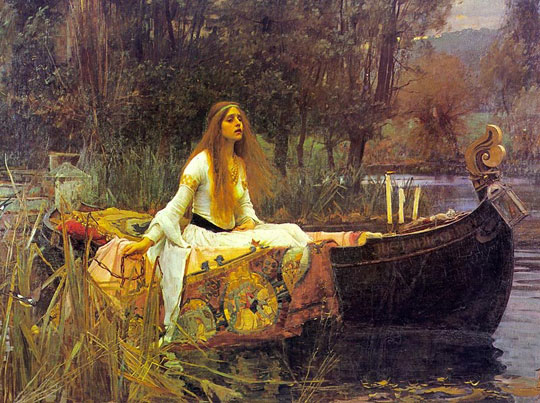A Deconstruction of Victorian Gender Identity through the Lady of Shalott
Meaghan Munholland & Matthew Wright
Ryerson University
1300
|
The medieval revival in the Victorian era was not a glorification of Britain’s mythical past, but rather a veneration of its present. Victorian society contemporized the chivalrous ideals of "knights" and "damsels," projecting self-reverence through popular medieval characters and settings.@ The depiction of Victorian society within an appropriation of Arthurian values is particularly prominent in regards to the construction of gender. Alfred Tennyson’s 1832 (revised in 1842) poem "The Lady of Shalott" first appeared in Poems, which was the second volume of the writer’s poetry to be published under his full name.@Anna Jane Barton, "'What profits me my name?' The Aesthetic Potential of the Commodified Name in Lancelot and Elaine." Victorian Poetry 44.2 (2006): 140. Tennyson’s poem epitomizes the projection of the specific gender roles assigned to men and women of the Victorian era through the medieval lens. As with many poetic works, there have been numerous visual materials associated with Tennyson’s poem. One of the most iconic paintings connected to Tennyson’s text is John William Waterhouse’s 1888 oil on canvas painting titled The Lady of Shalott. This exhibit demonstrates how distinct gender roles illustrated in both Tennyson and Waterhouse's works, respectively, mimic the socially constructed characteristics of the sexes throughout the Victorian era. Although Tennyson and Waterhouse's works were created more than half a century apart, both poet and painter construct similar representations of the masculine and the feminine, illustrating the stagnation of gender roles throughout a century credited with great change and progress. This exhibit explores how, and to what extent, both the poem and painting reflect specific traits that were derived from a Victorian projection of gender identities. |
Alfred Tennyson's "The Lady of Shalott" expresses the struggle of a young, forlorn woman who longs so desperately for the affection of a romanticized, ideal male companion that this longing ultimately leads to her death. This exhibits an overarching theme in many of Tennyson's poems: "the tension between the artist’s desire for aesthetic withdrawal and the recognition of the need for responsible commitment to society."@Jon C. Stott, Raymond E. Jones, and Rick Bowers. The Harbrace Anthology of Literature 2nd ed. (Toronto: Harcourt Brace Canada, 1997): 179. She becomes so enslaved by her desire for Lancelot that she loses all social value, thereby sacrificing her role as a "good" and obedient female. The idea of sacrifice is also evident in Waterhouse’s painting as the artist includes candles in his depiction of the Lady of Shalott. Burning candles are often elements in a sacrificial ceremony and in this sense Waterhouse uses the three candles, two of which are extinguished, to illustrate the self sacrifice of the Lady’s status and ultimately her forfeiture of life. She abandons her daily obligations and instead resorts to live in a far-off idea of chivalrous fulfillment in order to transcend her current condition. She desires an Arthurian knight in shining armour, who will act as her enabler and who will inject meaning into her otherwise fragmented and incomplete existence. In this portrayal of gender, femininity is endowed with fragility and powerlessness, while masculinity is embodied with strength and decisive action. The female character, in this regard, becomes the slave whose emancipation can only be enabled by the male (the master).
|
In Tennyson's poem the ideal of the protagonist remains unfulfilled. There is no plot-turn toward emotional relief; she is never saved or empowered by the man she longs for. Instead, her only act of pseudo-empowerment is the arguably unconscious provocation of the curse she is under, which ultimately leads to her death. The poem, then, ends with the irony of Lancelot watching her lifeless body float past him down a stream as he muses over her beauty. What makes this event even more ironic and tragic is how her death immediately follows a life of negation. At no point does she experience relief or fulfillment, "the Lady simply exchanges one kind of imprisonment for another; her presumed freedom is her death."@Shuli Barzilai, "Say That I Had a Lovely Face": The Grimms' "Rapunzel," Tennyson's "Lady of Shalott," and Atwood's Lady Oracle." Tulsa Studies in Women's Literature 19.2 (2000): 232. As a Tragedy of Errors, the poem alludes to a fundamental misunderstanding causing conflict and irresolution. The idea of female subservience stems from a patriarchal interpretation of femininity and both Tennyson and Waterhouse construct their "Ladies" to be pleasing to them as men and as masters/creators. |

John William Waterhouse
Photograph by Mendelssohn, c.1886.
|
The fact that the Lady is not named plays a significant role in establishing her identity, or lack thereof. Names signify identity to the external world and are internalized by the bearer.@Barton 135. In Tennyson’s poem, the title character is known as 'The Lady of Shalott' and her given name is never revealed. She is named after the physical space in which she is imprisoned. She is identified by her circumstance of captivity rather than as an individual. The negation of the Lady’s name illustrates that her position as a woman in need of a male rescuer is valued above her own identity. The Lady also illustrates the power of naming and its internalizing effect as she identifies herself as 'The Lady of Shalott,' inscribing the moniker on the side of her boat.


